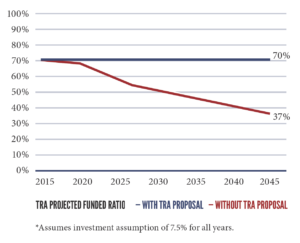Giving early learners in Minnesota a jump start and more effectively supporting teachers across Greater Minnesota are among the top legislative priorities identified by MREA members for the upcoming year. The MREA Board of Directors seeks formal approval of the full platform Nov. 14 at the annual meeting.
MREA presents a new solution to putting the state’s earliest learners first and settle political differences over early childhood education. Jump Start to School Readiness serves as a fiscal policy framework for state policy makers to consider.
In support of Minnesota educators, MREA urges the state to take action in 2018 to improve solvency for the Teacher’s Retirement Association (TRA).
The platform comes after several months of planning and research, dozens of meetings and conversations with over 200 members (school board members, administrators and teachers). Learn more.
The 2017 legislative session resulted in major action on E-12 funding and policy, yet new wrinkles were created and unfinished business remains. As we turn toward the shorter, non-budget 2018 session, MREA seeks approval for a legislative agenda that highlights our members’ principles and priorities. Members will vote on the platform Tuesday at the annual meeting.
Jump Start
Jump Start to School Readiness is a bold concept that will come with consternation, especially from parochial interests. While there is widespread understanding and support for the value of early learning opportunities, partisan and parochial rifts have developed.
The result is an unnecessarily complex web of funding streams and an inequitable patch quilt of programming for kids most in need. See table below on funding streams and view a map of served and unserved students district by district.
| PROGRAM FUNDING FOR FY 2018 (in millions) |
Minnesota | Total Federal, State & Local |
| School Readiness Plus (SR+)* | $25 | $25 |
| Voluntary Pre-Kindergarten | $25 | $25 |
| Early Childhood Family Education (ECFE) | $29.3 | $45.1 |
| Early Childhood Special Education (ECSE) | $65.8 | $121.9 |
| School Readiness | $33.6 | $33.6 |
| Early Learning Scholarships, Pathways I and II** | $70.2 | $70.2 |
| Head Start (including American Indian Program) | $25.1 | $94.1 |
| Child Care Assistance (CCAP and MFIP) | $160.1 | $249.1 |
| Total Annual Investment for FY 2018 | $434.7 | $664.6 |
*SR+ funded for ’18-19 biennium only
**$17 million Pathway II coordinated by school districts. Pathway I $ amount frozen at FY ’17 level.
In an attempt to balance competing pressures for parent choice and program stability, MREA envisions streamlining Pathway I & II, Voluntary PreK and the new School Readiness Plus revenues into the existing School Readiness fund in each school district.
Non-school 3&4 star providers would be eligible to access up to 40 percent of the consolidated funds sent to each school districts. Minimum program requirements would remain at 350 hours of service and funding would be driven by low-income pupil counts. Unused reserved funds would be released to school districts on June 30 each year.
Jump Start to School Readiness is premised on holding current Voluntary PreK school district revenue harmless and sufficient funding to serve all FRE eligible four-year olds at the minimum program requirements.
Teacher Needs
MREA members have also made it clear that shoring up the Teachers’ Retirement Association (TRA) is necessary to their ability to attract and retain high quality staff.
Recent actuarial reviews show longer lifespans for TRA retirees and a 12 percent lower expected rate of return on investments. Left unaddressed, the combination of these two factors will send TRA solvency on a downward spiral as seen in the chart below (based on a 7.5 percent investment).
 In order to secure a defined benefit pension for teachers, significant action should be taken by the legislature this session. The medicine will be tough for all parties including, schools, teachers, retirees and the state, but TRA is an important cornerstone of our current compensation package for teachers and must be maintained.
In order to secure a defined benefit pension for teachers, significant action should be taken by the legislature this session. The medicine will be tough for all parties including, schools, teachers, retirees and the state, but TRA is an important cornerstone of our current compensation package for teachers and must be maintained.
Facility Fallout
The Legislature has taken major action to create more fairness in school facility funding. Long Term Facility Maintenance and the new Ag2School bond credit are extremely helpful. However, additional work is requested to create more flexibility and options for facility maintenance and improvements.
Addressing student opportunity gaps in the areas of concurrent enrollment, ELL and mental health services are needed. Cooperative assistance for school improvement and technology equity should be addressed by the legislature.
MREA is also supporting our rural community partners in their efforts to improve our economic and workforce development needs, specifically by improving broadband and quality, affordable child care access.





